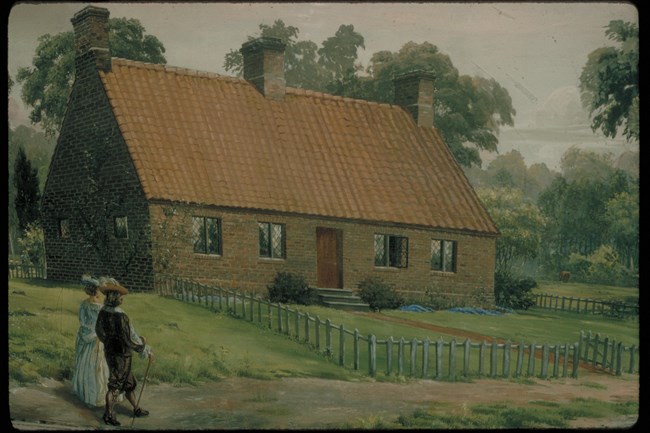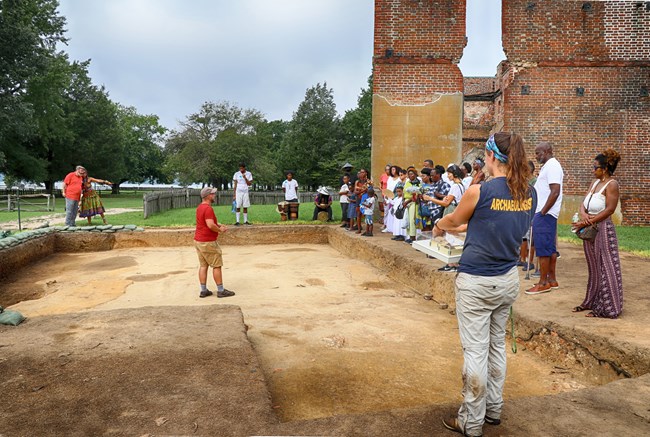Last updated: March 6, 2023
Article
Archeology and the Enslaved Laborers at Travis Plantation

Run away from my plantation at Jamestown, sometime this last August, a likely mulatto man named Jessee, 17 or 18 years old, tall and slender. I expect he is either enlisted into the army or enlisted on board some vessel as a sailor and freeman. Whoever secures the said slave in any jail so that I get him again or delivers him to me at Queen’s Creek in York County, shall have 20 dollars reward.
Travis also offered a $100 reward for a 10-year-old child named David, who he believed had fled to Portsmouth with the idea of going to sea. In 1779, a 35-year-old man named Robert Bowland reportedly took up the British army’s offer of freedom and escaped the Travis plantation, boarding the L’Abondance headed toward Port Matoon in Nova Scotia.
The ideals espoused in the Declaration of Independence were, ironically, written with enslavers in mind. Men like Travis who supported and participated in the American Revolution rationalized slavery in a nation that promoted ideas of liberty and freedom, despite the lived experience of many people to the contrary. Archeology at the Travis plantation brings to light what life was like for enslaved people during these contradictory times.
People left an archeological record on Jamestown Island dating back thousands of years. By the sixteenth century, Powhatan emerged as a leader of several chiefdoms of Virginia Coastal Plain peoples, ruling from villages such as Werowocomoco on the York River. The arrival of Europeans in the seventeenth century set off the Anglo-Powhatan Wars, a series of raids spurred by the influx of colonists hoping to capitalize on tobacco, a cash crop that became the primary product of the Chesapeake economy. Yeoman farmers, or Euro-American families who worked on their own small plots of land, dominated the landscape until the early eighteenth century, when Virginia’s ruling class, or gentry, started to absorb smaller farms into their expansive plantations.

Major Edward Travis inherited his family’s plantation - 1,652 acres of land - after his father’s death in 1745. From 1750-1758, he became involved in the slave trade. His sloop, the James Town, transported enslaved Africans from Barbados to Virginia. By the 1760s, nearly 90 enslaved Africans or African Americans lived on Jamestown Island between the Ambler and Travis plantations.
Travis enslaved 44 people on his plantation in 1768. They witnessed British threats to Jamestown Island in 1775 and the use of the Travis plantation for a base of operations during the American Revolution. We know the names of some of the Africans and African Americans through the Travis’ agricultural and financial records, but archeology has uncovered evidence of where they lived, the kinds of objects they kept in their homes, and how they used them.

During the initial site identification, archeologists recovered over 700 artifacts dating to the mid-eighteenth century. About 40 of them were ceramic tableware, cooking vessels, or storage containers in styles including Rhenish blue and gray, English stoneware, delftware, white salt glazed stoneware, creamware, and pearlware. The array of styles reflects the Travis’ wealth and position as one of the colony’s prominent landowning families.

While archeologists previously assumed that enslaved people used ceramic vessels of European origin, they now understand that industrially manufactured ceramics were less available to them at this time. The coarse earthenware pots could be similar to colonoware, a type of ceramic made by enslaved people using local clays to mimic European vessel styles that has been found in archeological contexts at other parks. Potters who produced colonoware were asserting their position within an oppressive social order, creating similar household objects to challenge the racial hierarchy and attempt to close the gap between superior and inferior social statuses.
Archeology is a method of studying material assemblages, and these artifact scatters convey patterns of asserting personhood and using space to undermine the enslaver-controlled landscape. By maintaining agency and individuality in consumption, the enslaved created their own culture and constructed their own identity based on the ceramic artifacts that were left behind. Resilience is evident in their expressing their own sense of community belonging by adapting to a shared history that they were forced to live within.

Sources:
Agbe-Davies, Anna S.
2018 "Laboring Under an Illusion: Aligning Method and Theory in the Archaeology of Plantation Slavery." Historical Archaeology, vol. 52, no. 1, pp. 125-139.
Blanton, Dennis, Patricia Kandle, and Charles M Downing
2000 Archeological Survey of Jamestown Island. Colonial Williamsburg Foundation and the College of William and Mary, Williamsburg.
Fischer, Lisa
2013 Site 44JC900 (Survey Site 15) Summary Form. William & Mary Center for Archaeological Research (WMCAR), pp. 1-4.
Horning, Audrey
2006 "Archaeology and the Construction of America's Jamestown." Post-Medieval Archaeology, vol. 40, no. 1, pp. 1-27.
McCartney, Martha
2000 Jamestown Archaeological Assessment: 1992-1996. Documentary History of Jamestown Island. Volume I: Narrative History, Volume II: Land Ownership, Volume III: Biographies of Owners and Residents. Colonial Williamsburg Foundation and the College of William and Mary, Williamsburg.
2003 A Study of Africans and African Americans on Jamestown Island and at Green Spring, 1619-1803. Colonial National Historical Park and Colonial Williamsburg Foundation.
Newby-Alexander, Cassandra L.
2020 "The 'Twenty and Odd'." Phylon (1960-), vol. 57, no. 1, pp. 25-36.
Reid, L. Chardé
2021 “’It’s Not About Us’: Exploring White-Public Heritage Space, Community, and Commemoration on Jamestown Island, Virginia." International Journal of Historical Archaeology, pp. 1-31.
Sikes, Kathryn Lee McClure
2013 "Peripheral Vision: Mimesis and Materiality along the James River, Virginia, 1619-1660." PhD Dissertation, The College of William & Mary.
Tags
- historic jamestowne part of colonial national historical park
- archeology
- archaeology
- virginia
- african american
- european american
- plantation
- african american history
- african american heritage
- slavery
- freedom seekers
- enslavement
- early republic
- american revolution
- agricultural history
- european american history
